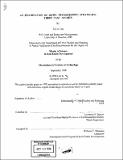| dc.contributor.advisor | Lawrence S. Bacow. | en_US |
| dc.contributor.author | Ng, Lily K., 1967- | en_US |
| dc.date.accessioned | 2012-02-29T17:24:56Z | |
| dc.date.available | 2012-02-29T17:24:56Z | |
| dc.date.copyright | 1998 | en_US |
| dc.date.issued | 1998 | en_US |
| dc.identifier.uri | http://hdl.handle.net/1721.1/69405 | |
| dc.description | Thesis (S.M.)--Massachusetts Institute of Technology, Dept. of Urban Studies and Planning, 1998. | en_US |
| dc.description | Includes bibliographical references (leaf 107). | en_US |
| dc.description.abstract | Hotels differ from ordinary commercial real estate in that lodgings require extensive management to maintain daily operations to generate revenue and cash flow. Also, hotels do not have defined income streams, such as long-term tenant leases that are typical in other types of real estate. A fluctuation of income reflects both daily room rental characteristics and the timing of economic cycles. A hotel's assets encompass its locational and physical attributes, as well as the business value generated by the hotel's cash flow, which relies heavily on the management's expertise and marketing abilities. When a hotel's image and product quality no longer match its desired position, the owner has the option to reposition the property. Repositioning is often triggered when a property is under-performing, suffering from financial distress and/or experiencing changes in ownership. The primary objective of repositioning is to improve the property's performance. The objective of this thesis is to explore the core issues and areas of concern which owners should be aware of when repositioning a hotel property. Specifically, Chapter One of this thesis sets up the parameters by which repositioning strategies can be evaluated. The chapter establishes the framework of the "resource-based" view of strategies, suggesting that the basis of a sound strategy starts with an entity's resources. Building on this view, this thesis will discuss the role that economic life cycles, branding, segmentation and externalities play on repositioning. The underlying strategies, applications and results of each case are discussed and examined. Finally, Chapter Five presents the implications of the cases and the main lessons learned from them. | en_US |
| dc.description.statementofresponsibility | by Lily K. Ng. | en_US |
| dc.format.extent | 107 leaves | en_US |
| dc.language.iso | eng | en_US |
| dc.publisher | Massachusetts Institute of Technology | en_US |
| dc.rights | M.I.T. theses are protected by
copyright. They may be viewed from this source for any purpose, but
reproduction or distribution in any format is prohibited without written
permission. See provided URL for inquiries about permission. | en_US |
| dc.rights.uri | http://dspace.mit.edu/handle/1721.1/7582 | en_US |
| dc.subject | Urban Studies and Planning | en_US |
| dc.title | An examination of hotel repositioning strategies : three case studies | en_US |
| dc.title.alternative | Repositioning hotel strategies : three case studies | en_US |
| dc.type | Thesis | en_US |
| dc.description.degree | S.M. | en_US |
| dc.contributor.department | Massachusetts Institute of Technology. Department of Urban Studies and Planning | en_US |
| dc.identifier.oclc | 42368448 | en_US |
